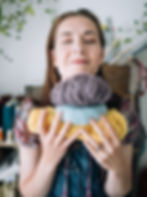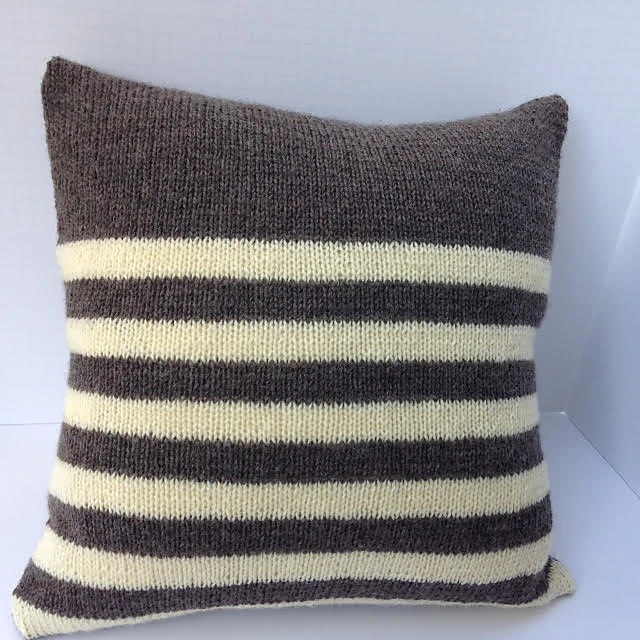3 Easy Knitting Projects for Beginner Knitters
- learntoknitonline
- Feb 20, 2023
- 10 min read
Updated: Apr 12, 2024
So, you have learnt to knit and purl, cast on and off and now you want to make something. Knit something to actually wear, or maybe to gift a loved one. You want to knit something of your very own and feel proud every time you wear it or see it being worn and enjoyed. I remember that hunger well.
As soon as I had some initial confidence in my new knitting skills, I was so eager to not only wear things I knitted myself but make items to gift my loved ones and feel the pride in seeing them wear something I knitted especially for them. I don't think my friends and family had a non-knitted gift for me for the first 4 years I had learnt to knit!
Where Do I Start?
As a beginner knitter, you can often feel overwhelmed with where to find a knitting pattern and unsure of whether it will be a knitting pattern you can follow and knit well. Will it be worth your time and effort? Will it be too advanced and risk putting you off your new found crafty passion?

As a self taught knitter, I have been there and this blog post is the one I wish I could have found (over 18 years ago). My whole mission with Learn to Knit Online is to demystify the world of knitting for Beginner Knitters and make it accessible and fun. So here is a carefully curated selection of easy, free and totally manageable beginner knitting projects that you can get knitting with your new knitting skills immediately.
If you want a bundle of 5 Beginner Knitting Project patterns, including 4 of the actual examples featured in this blog post, head here and get the knitting pattern bundle in your inbox instantly.
FYI: All the knitting skills required by the knitting patterns I have linked in this post are covered in my Learn to Knit Online The Beginner's Knitting Course (available with instant and lifetime access).
Without further delay, let's get to these fab easy, beginner knitter projects that you can cast on and knit today.
1) THE SCARF
Knitting skills needed: Casting On, Knit Stitch, Purl Stitch, Changing Yarns (either as colours or new balls of yarn) and Casting Off
A scarf is a universally appreciated, gender free, wearable garment you can knit for anyone, from kids to adults, almost everyone loves a cosy scarf.
The Scarf Knitting PROS:
The brilliant thing about knitting a scarf is, the possibilities are endless. Whether you want to play with knit and purl stitch combinations to create texture, or stripe colours to make something unique and personalised or add tassels, pom poms, make it extra long, experiment with yarn thicknesses as stripes instead of colours...whatever knitting skill you choose to utilise, you can knit into a gorgeous scarf.
The Scarf Knitting CONS: The only downer about knitting a scarf is you do need patience. A scarf takes time. No one wants a scarf too short to comfortably and easily wrap around their neck, so you need to prepare yourself for the inevitable challenge of feeling bored at the half way point of knitting a scarf.
This is when changing up colours, yarn thicknesses or just thinking about the end product is super helpful to motivate yourself to keep on knitting it. Imagine all the cosy walks it will be taken on, the compliments it will receive and the pride you will feel every time you wrap it around (and maybe around again) your neck.
My Scarf Knitting Top Tips:
Pick a decently sized needle size - the bigger the needle, the quicker the knit. I like to knit my scarves on 5-8mm needles. Not only do I prefer a chunky knit scarf but it also it ensures I can motivate myself to finish it, knowing it won't take months to complete.
Choose a yarn you love to feel in your fingers and ideally one that has some form of colour changes (if using just one colour) so a hand-dyed or variegated yarn. Every little patch of colour change motivates me to knit to the next one to see how it looks from pretty ball to stunning scarf.
Find an inspiration photo of someone in a gorgeously luxuriously long scarf - this often spurs me on to knit it longer and not bail and cast off before it is my dream length.

BONUS KNIT TIP
Have a smaller knitting project on the go at the same time as knitting your scarf. Being able to pick up something less time intensive and ideally with different knitting skills/stitch combinations as this helps you get to take a 'knitting break' and recharge your motivation to finish your bigger project.
Want the patterns to make these scarves and more? Sign up to my newsletter, The Loop and get a 5 Beginner Knitting Pattern Bundle in your inbox instantly
2) The CUSHION COVER
Knitting skills needed: Casting On, Knit Stitch, Purl Stitch, Changing Yarns (either as colours or new balls of yarn), potentially some Stranded Colour work , Shaping Techniques (for buttonholes) and Casting Off
A knitted cushion cover is the perfect way to cosy up your living room. Why not knit a variety of cushions that are both irresistible to snuggle with while also a subtle (yet memorable) way to show off your new knitting skills. Knitted cushion covers also make great unisex gifts and can be easily personalised. Everyone loves a cushion, throw it on your sofa, bed, armchair, home office chair. It will always be welcomed and make a space welcoming.
The Cushion Cover PROS:
Knitting a cushion cover, no matter the stitch pattern or colour-work design, is pretty straightforward. You knit a piece long enough to cover your cushion pad twice comfortably and sew the side seams together, if not adding buttons then you simply sew the top seam once you have your cushion safely tucked inside.
Another easy to adapt basic pattern, once you feel confident in having followed any of these easy, beginner knitting patterns you can experiment with changing colours, striping, playing with texture, knitting shapes and letters using strategically placed purl stitches on a knit side. There is so much you can do when knitting a cushion cover. It's also often a quicker knit than a scarf or blanket so you get the satisfaction of a completed knitted project sooner rather than later.
The Cushion Cover CONS:
It can feel a slightly tedious knit if you go for plain garter (knitting every stitch) or stockinette (alternating knit and purl rows) so it may be worth having some other colours to hand in the same yarn weight so you can throw in a stripe every now and then.
If you don't opt for adding buttonholes (and therefore sewing on buttons) then you will need to consider where the cushion is going to live, in order to avoid spills and stains etc. Without buttons it will mean undoing the seam to wash it, which can be a faff. Or ensure it will only ever need a spot wash at most. Also be aware that most pets will become very attached to your beautiful knitted cushion, who can blame them?
My Cushion Cover Knitting Top Tips:
Consider where it is destined for and what kind of stitch pattern or colours that space will best suit. You have a great opportunity to make something bespoke for your home/workspace.
Buy your cushion pad before starting to knit your cover to ensure you are not left with a beautifully knitted cover waiting for you to track down a randomly sized cushion pad. Or, if you are using an existing cushion, be sure to double check the measurements of it.
Knit a gauge swatch. Check your needle size is the right one for the width and length of your specific cushion pad as if you end up knitting the cover too loosely or tight, it will not fit and will just feel frustrating after all the work you put in. You can follow my step by step Gauge/Swatch tutorial HERE (it is #Tip 8).

EXTRA KNIT TIP
Don't be scared to design your own cushion cover knitting pattern to knit up. Once you know the width and height you need to knit for your knitted cover (and you've done your gauge swatch to determine how many stitches to cast on, how many rows to knit), you can play around with the colours and textures.
Grab some graph paper (squared paper) and plot out a shape or letter and every time you come to one of those 'x' you marked on your paper, work a purl stitch on a knit side (or a knit stitch on a purl side) and watch your design come to life simply by adding a textured stitch.
Want the knitting pattern for an easy cushion cover and 4 more beginner knitter patterns including the scarves and a blanket? Sign up to my newsletter, The Loop and get a 5 Beginner Knitting Pattern Bundle in your inbox instantly
3) The BLANKET
Knitting skills needed: Casting On, Knit Stitch, Purl Stitch, Changing Yarns (either as colours or new balls of yarn) and Casting Off
Who doesn't love a cosy, knitted blanket to cuddle up with on the sofa while enjoying a brilliant book and with a hot drink within arms reach? It just completes the snuggly scenario. Without it you'd be...well fine, but just not as comfy and if you knitted that blanket yourself, smug!
The Knitted Blanket PROS:
A knitted blanket is an heirloom piece, looked after well it can be handed down to generations to come with memories passed on with it. Especially if made in a sustainable fibre such as Merino or Alpaca, as wool is almost completely stain resistant.
It also will keep you warm on the sofa while you knit it. The more you knit, the bigger it grows ands before you know it it is doubling simultaneously as both a lap blanket and crafty, creative knitting project. A preview of what your blanket will be when you have finished it and how much it will be enjoyed once you have.
Plus there are all types of size blankets out there to choose from, such as baby blankets to log cabin style blankets and even throws, for those that are really ambitious.
The Knitted Blanket CONS:
Much like the scarf, knitting a blanket requires patience and time. As a gift this will require some planning in terms of knitting time, although there are plenty of 11th hour blanket patterns out there. Knit on huge needles there is always a speedy option.
The other con about knitting a blanket is that the amount of yarn required can make this a pricier project than most. BUT having said that, there are lots of stash busting options out there, where you purposefully use ends of yarn leftover from other knitting projects so don't feel it can only be knit in a lot of brand new yarn.
My Blanket Knitting Top Tips:
Unless it is a baby blanket, avoid needle sizes from 4mm and smaller - a lovely big blanket knit on 5mm needles can be a gorgeous one, and although it will take time to knit up, it will be faster than knitting on smaller needles.
Get yourself a circular needle with a long length cable, I would use a 100cm or bigger circular needle and knit it back and forth, as if they were straight needles. The cable (or wire if that is how you consider it) will hold the stitches. Straight needles will just not be long enough to hold all the stitches needed for a good width blanket.
Set yourself a daily or weekly challenge of rows to complete on your knitted blanket. Depending on the width of the blanket I am knitting, from single to double, I often set a manageable amount of rows to do each evening and often it spurs me on to complete twice the amount.

'KNITSPIRATION' IDEA
Follow any of these blanket patterns linked below or create your own and select a group of yarn colours that reflect the weather, temperature or your moods/emotions. Everyday pick a colour from your palette to knit a row or two of your blanket - depending on how many rows you do a day you will have a knitted form of thermometer by the end to represent the year or 6 months it took you to knit. Like a knitted journal!
If you want the finished blanket faster, just knit more rows a day.
Fancy knitting the middle blanket? Sign up to my newsletter, The Loop and get this pattern and 4 more Beginner Knitting Patterns in your inbox instantly
Excited and Inspired to get Knitting?
I hope so, I would love to know which of these projects you are going to kick off your knitting journey with? My very first project was a scarf, it was a ridiculously long one but that was because I hadn't learnt how to cast off and so just kept knitting...Following that I made more scarves, snoods, cushion covers and blankets before I moved onto hats, socks and sweaters.
Knitting is addictive and having a finished item that you can physically wear/enjoy is a high like no other. It is a representation of your achievement, self belief, patience. A finished knitted piece is what spurs you on to pick your needles back up and create something else, entirely handmade with just some yarn and needles.

Knitting is Easy, Knitting is Relaxing (eventually)
My husband still considers knitting a work of magic, and maybe it is. However if you have taken my Beginner Knitting Course or are a Beginner Knitter reading this, you'll already have a strong suspicion that knitting is pretty easy (spoiler alert: you are absolutely right), just take it step by step, keep breathing and tell that inner voice of fear where to go - you've got some knitting to do and it will just get in your way and ruin your sense of accomplishment. Everything new feels tricky, but knitting is the same actions repeated over and over, if you trust the process you will soon find your flow.
Want to Become a Better Knitter?
It's very simple, the more you knit, the more you improve. Every time you experience a hurdle, a dropped stitch, any type of confusion and panic, you can take a breath and step by step, learn how to conquer it. All of these moments help your confidence grow, your self belief increase. And the more knitting experience you have under your belt helps quieten that imposter syndrome voice of worry and fear. So when tackling those big knit projects like knitting a scarf or a blanket, keep reminding yourself that every row you knit is strengthening your knitting skills.
I guarantee that the first knitted row of your first scarf will look very different to your last row - make sure you take a moment to see that and feel proud of yourself!
Happy Knitting!
So, what are you waiting for? Choose your knitting project, pick out your yarn and cast on! I am cheering you on and excited for you to start your knitted collection of items and gifts.
If you need any tips, guidance or support check out my free Knitting TIPS page or book a Personal Project Session with me and together we can break your knitting pattern down (while also recording the session) and get you knitting with confidence and joy.
PIN this post for later

If you are a beginner knitter or simply want to brush up on your skills, check out my Beginner Knitting course, book a LIVE, Interactive class with me or pick the specific skills class you need with the Single Knitting Class options.
Be sure to subscribe to my blog (by signing up as a member of my website) to see all my handy, helpful beginner knitting guides and tutorials.
















